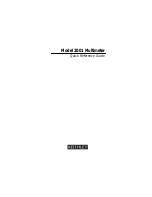
4
6.1 Method of measurement
Warning! Dangerous voltages may
be present at the input terminals and
may not be displayed.
6.1.1
Voltage measurement
•
Set the measurement range dial at the re-
quired position
or
.
•
Connect the black test lead to the meas-
urement socket "COM" and the red test lead
to the "V/
Ω
" socket. The meter is connected
parallel to the measuring point. The polarity
of the red lead connection will be indicated
at the same time as the voltage.
Note
•
lf the voltage to be tested is unknown be-
forehand, set the measurement range dial to
the highest range and work down.
•
When only the figure "1" is displayed, over
range is being indicated and the measure-
ment range dial has be set to a higher
range.
•
Never measure voltages higher than 1000 V.
6.1.2
Current measurement
•
Set the measurement range dial at the re-
quired position
or
.
•
Connect the black test lead to the meas-
urement socket "COM" and the red test lead
to the "A" socket for measurements up to
2 A. For measurements over 2 A connect it
to the socket “20A”. The meter is connected
in series to the measuring object. The polar-
ity of the red lead connection will be indi-
cated at the same time as the current.
Note
•
lf the current to be tested is unknown be-
forehand, set the measurement range dial to
the highest range and work down.
•
When only the figure "1" is displayed, over
range is being indicated and the measure-
ment range dial has be set to a higher
range.
•
Limit measurements in the 20-A range to
max. 15 s.
6.1.3
Resistance measurement
Warning! To avoid electrical shock
or damage to the meter when meas-
uring resistance in a circuit, make
sure the power to the circuit is
turned off and all capacitors are
discharged.
•
Set the measurement range dial to the
Ω
range.
•
Connect the black test lead to the meas-
urement socket "COM" and the red test lead
to the "V/
Ω
" socket. Measurement is done
parallel to the resistor
Note
•
lf the resistance to be tested is unknown
beforehand, set the measurement range dial
to the highest range and work down.
•
When only the figure "1" is displayed, over
range is being indicated and the measure-
ment range dial has be set to a higher
range.
When the input is not connected, i.e. at open
circuit, the figure "1" will be displayed for the
over range condition.
6.1.4
Diode test
•
Set the measurement range dial to
.
•
Connect the black test lead to the meas-
urement socket "COM" and to the cathode of
the diode. Connect the red test lead to the
"V/
Ω
" socket and the anode of the diode.
Note
When the input is not connected, i.e. at open
circuit, the figure "1" will be displayed
The meter displays the forward voltage drop and
displays figure "1" for overload when the diode
is reversed.
6.1.5
Continuity test
Warning! To avoid electrical shock
or damage to the meter when meas-
uring continuity in a circuit, make
sure the power to the circuit is
turned off and all capacitors are
discharged.
•
Set the measurement range dial to
.
•
Connect the black test lead to the meas-
urement socket "COM" and the red test lead
to the "V/
Ω
" socket.
A built-In buzzer sounds if the resistance is less
than 30 ± 10
Ω
.
6.1.6
Transistor hFE test
•
Set the measurement range dial to
hFE
.
•
Make sure the transistor is "NPN" or "PNP"
type. Insert the transistor correctly into the
corresponding transistor test socket.
Display reading is approx. transistor hFE value.
Base current approx. 10 µA, V
CE
approx.2.8 V.
6.2 LCD Display panel angle selection
LCD display panel is locked in lie down position
in normal operating condition and storage.
•
To change the display panel angle, push
down the button which is above the top
case, and release lock.
•
Rotate the display panel to the best angle.























